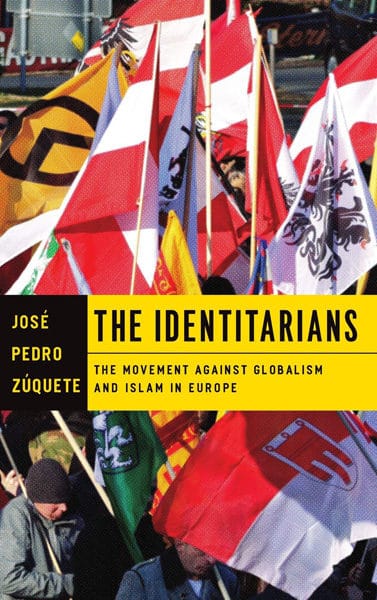Finally, a Useful Book on Identitarianism
Robert Hampton, American Renaissance, February 19, 2019
Jose Pedro Zuquete, The Identitarians: The Movement Against Globalism and Islam in Europe, University of Notre Dame Press, 2018, 484 pp., $34.00.
The rise of the Identitarian movement gives hope to the West. Young people throughout Europe have taken to the streets to defend their people and have created a subculture of dissent.
Jose Pedro Zuquete’s The Identitarians: The Movement Against Globalism and Islam in Europe offers the most in-depth and fair analysis of the movement in the English language. Over the past few years, many articles and books have been written about nationalist movements, but they often smear subjects as “Nazis” rather than describe them accurately.
Dr. Zuquete, a research fellow at the Social Sciences Institute of the University of Lisbon, is not looking for out-of-context quotes. Instead, he lets Identitarians speak for themselves. He explains the intellectual roots of Identitarians, their goals, how they respond to globalism and radical Islam, how they handle race and national sovereignty, and what their future may be.

Dr. Zuquete has studied two movements in depth: Generation Identity, a youth-based movement that started in France, and Italy’s CasaPound. The author calls both Identitarian but consistently distinguishes between them. Generation Identity is pan-European, racially aware, and disavows fascism. CasaPound is nationalist, tends to avoid racialism, and embraces the legacy of Italian Fascism.
Still, the groups have much in common: They are opposed to traditional conservatism, globalism, and deracinated individualism. Both support ethnically-rooted identities and communitarianism, and both are youth-centered and contemptuous of European elites. Neither group is primarily dedicated to electoral politics, even though CasaPound recently began running in local elections.
The main purpose for both groups is “metapolitics,” meaning they are more focused on changing culture than on winning elections. Identitarians hold rock concerts, run pubs, host martial arts training, serve their communities, and engage in other non-traditional political activities to promote an ethnocultural identity among young people. The Identitarian movement is like a subculture, with its own symbols and language.
Dr. Zuquete does not give a figure for how many Identitarians there are in Europe, but he does note that the movement has expanded into Germany, Austria, Belgium/Flanders, the UK, Denmark, Italy, Hungary, Ireland, and Czechia. CasaPound-associated groups exist in Spain, France, and Greece.
In France, Identitarians have significant ties to the National Rally (formerly known as the National Front). Identitarian leader Philippe Vardon is an elected official for the National Rally and recently became a part of the party’s national bureau. Many of the advisers for the young National Rally leader Marion Marechal come from the Identitarian movement, and Identitarians believe they are influencing the future direction of the party.
Identitarians influence public debate through activism. One example was “Defend Europe,” which chartered boats to block NGO-operated migrant ships in the Mediterranean. Dr. Zuquete writes that this “managed to put the Identitarians at the very center of a mainstream media frenzy.”
Dr. Zuquete traces the intellectual foundations of the Identitarians back to the Nouvelle Droite (ND) popularized by Alain de Benoist in the 1970s. The ND sought to break away from both traditional conservatives and European fascism and stressed identity as the foundation of politics.
Nevertheless, Identitarians see the ND as too intellectual and detached. The activists are critics of Mr. Benoist and his circle’s “communitarian” approach to multi-racial societies. Mr. Benoist and other prominent ND intellectuals have distanced themselves from past racialist views and now call for the “cause of peoples.” Mr. Benoist wants to establish ethnic communities living side by side, whereas Identitarians fight for European peoples only and want non-Europeans to go home. Dr. Zuquete quotes Mr. Benoist criticizing Identitarians for “assigning ethnic factors the role that Karl Marx assigned economic factors.”
Many ND figures — including Guillaume Faye, Dominique Venner, Pierre Vial, and Robert Steuckers — disagreed with Mr. Benoist’s downplaying of race. Dr. Zuquete often quotes these dissidents because he thinks they more accurately represent the views of Identitarian activists.
Dr. Zuquete dedicates an entire chapter to how Identitarians treat race. He writes that there are two different approaches, which he calls “racialist” and “pragmatist.” The racialists talk openly about race and promote racial science. They understand the importance of biological identity. They argue that miscegenation is a serious threat to European identity and that the continent’s racial stock must be preserved.
The pragmatists do not directly oppose racialist arguments, but they see them as politically disadvantageous. The pragmatists in Generation Identity attack the system’s anti-white bias, but they do not (at least openly) stress the importance of racial identity. Dr. Zuquete calls this a “goes-without-saying” approach to race.
CasaPound, on the other hand, has an aversion to racialism and boasts of its immigrant members. The Italians also praise their Fascist predecessors for giving citizenship to Libyans and other non-Europeans.
Both pragmatists and racialists are fighting “The Great Replacement.” With the exception of CasaPound, the racialist vs. pragmatist divide is more about political tactics than actual beliefs.
Identitarians have a low opinion of America. Some believe America poses as much a threat to Europe as Islam. CasaPound even argues that American-led global capitalism is a greater threat to Europe than mass migration and Islam. Nearly all Identitarians want a future that is entirely independent of the United States.
Still, Identitarianism has influenced American nationalists, and Dr. Zuquete covers how the movement influenced the Alt-Right. He also notes Identity Evropa’s attempt to create an American version of Generation Identity. However, even as Europeans have adopted many of the “memes” and internet activism of the Alt-Right, their leaders think Americans are too focused on race. Identitarian leader Martin Sellner is quoted as saying that Americans need to “find a clear position against racism/racial supremacy and anti-Semitism.”
Many Americans are quoted in Dr. Zuquete’s book, including American Renaissance editor Jared Taylor, Identity Evropa’s Patrick Casey, and Counter-Currents editor Greg Johnson. Mr. Taylor explains that American Identitarians talk more about race than Europeans because we don’t have the luxury of the “goes-without-saying” approach:
In this respect, Europeans have an advantage over Americans . . . . Americans have no choice but to speak in terms of race as our unifying factor, whereas European nationalists can emphasize language, history, and culture without specifically talking about race. Anti-identitarians are especially provoked by expressions of white racial solidarity, so it may be useful for Europeans to avoid explicitly racial appeals.
This book paints a bright future for the Identitarian movement. Dr. Zuquete does not end with a “soothing, therapeutic finale” that dismisses Identitarians as a minor nuisance to the triumph of tolerance. His purpose is to provide an accurate picture of one of Europe’s most important political movements — and he succeeds brilliantly.















